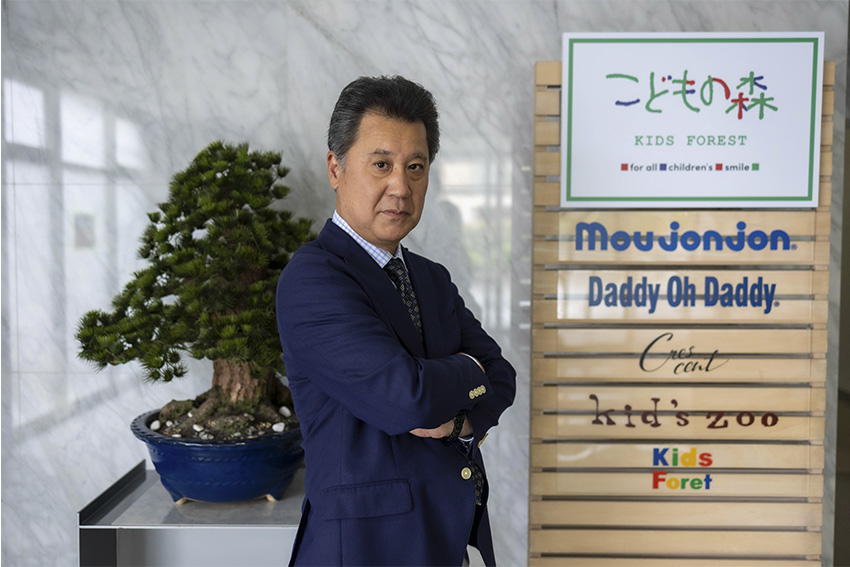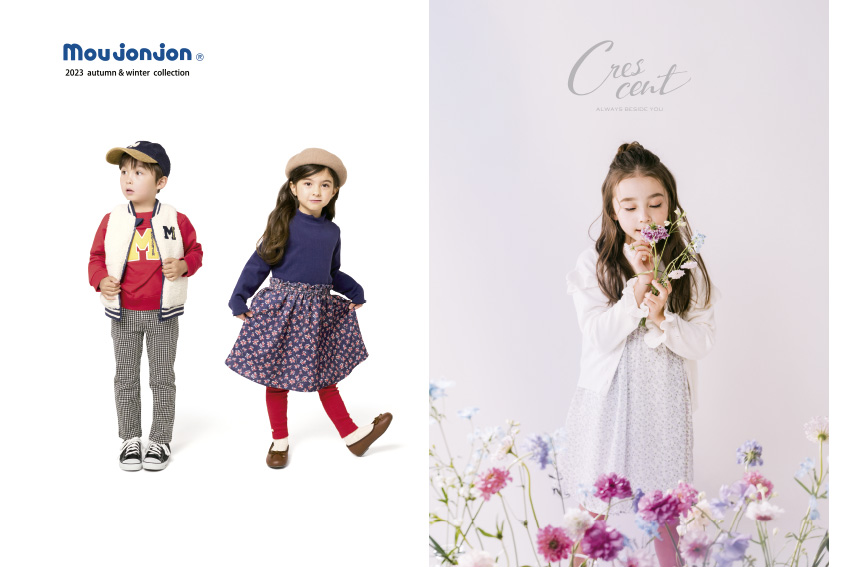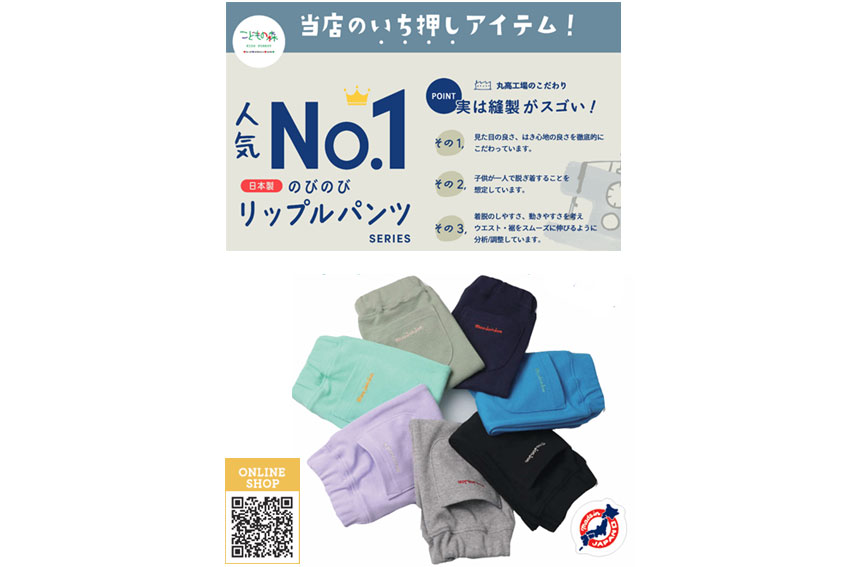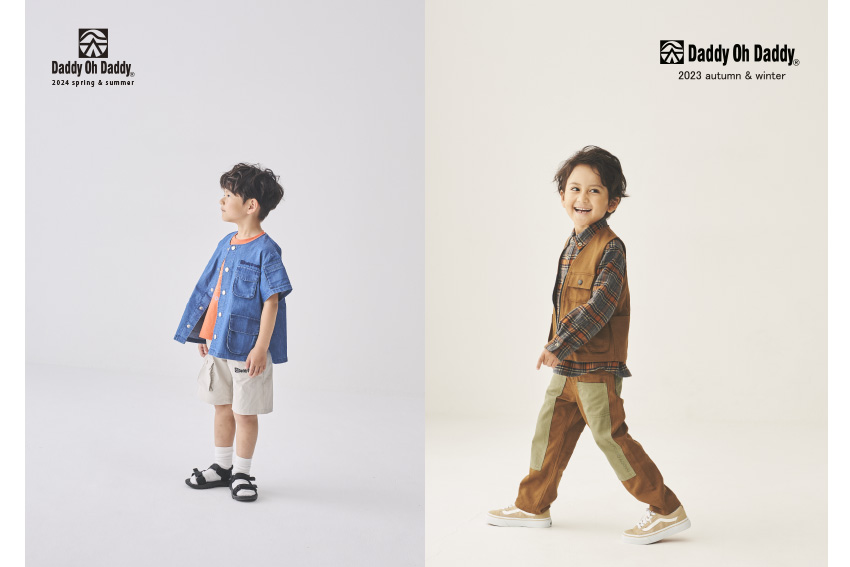Children's smiles make us adults happy, and that desire is the starting point for Marutaka Clothing’s business philosophy

What cultural and historical factors contributed to the development of Japan's unique approach to manufacturing and resource management?
The feelings of fear and awe that Japanese people have toward nature may be stronger than those of other nationalities. Japan has had its religion, Shinto, since ancient times. Shinto is a religion that has no founder or guru and no clear scriptures like Christianity or Islam. Instead, it believes that gods reside in all things in nature. Japanese people do not have the awareness in their daily lives that they clearly belong to "Shinto," but they often pray at milestones in their lives. For example, when they take exams, get married, construct new buildings, wish for a good harvest of crops, or have a prosperous business, etc. There are small shrines in every region of Japan, and each year, a festival is held there to thank the gods for their blessings, with people of all ages and both sexes participating. The Fushimi Inari Taisha shrine in Kyoto, which is very popular among Westerners, is also a Shinto shrine where people pray for a good harvest.
In Japan, natural disasters such as earthquakes, typhoons, and floods occur yearly and cause damage throughout the country. Even today, with the development of science and technology, it takes considerable time to recover from such disasters. When science and technology did not exist in the past, it would have required significant effort and time to recover. Japanese people accept such disasters as ordeals from nature (God), and to overcome them, local people inevitably had to cooperate, and they overcame them. This is the basis of the Japanese way of thinking. Japan has many natural disasters and few natural resources. The Japanese people have a sense that everything is given to them by nature (God), which they fear, and this may have led them to treat things with care and to recycle.
Mottainai, a word that symbolizes the Japanese people, may have been inspired by this Japanese way of thinking. During the Edo Period, Japan had about 35 million people. We used to make and repair goods to continue using the same goods for a long time. For example, when human feces were fermented, the heat of fermentation killed the bacteria, and they were reused as fertilizer and traded. The reason for this was that we did not have a lot of resources. The same goes for flooring materials such as tatami. It was made of dried rice straw after the rice had been harvested. This was also the case for kimonos. Once a kimono became old, it was broken down and resewn to be used as new clothes. This was the mindset of the Edo period and the early Showa period. Japanese people tended to take good care of the things they used so that they could be reused. That spirit is reflected in the Japanese manufacturing method of monozukuri. Japanese manufacturers pay close attention to detail so the product can be used for a long time.
During the Edo period, Japanese society was trying to achieve a recycling-oriented society rather than expanding its market share. As a result, Japan experienced little economic growth. This changed when the country was opened up to the West. After we became Westernized, we started competing with overseas competitors. They began seeking to expand their market share.
Many aspects of Japanese culture are derived from that of ordinary people, such as KABUKI, BUNRAKU, and RAKUGO. On the other hand, in Western countries, many of these aspects were driven by the culture of the nobility. Although the Japanese economy did not grow much during the Edo Period, people used to enjoy the circulation of the economy and culture. Ordinary people were not wealthy, but they had secured a particular lifestyle; a culture of the common people was likely born. This was one of the positive aspects of the closure of the country to the outside world during that period. In this period, the lords (feudal lords) also ruled and educated the common people to secure a certain standard of living, although they were not wealthy. (Even during the Edo period, most people in Japan could read.) This is thought to be why there were no major bloody revolutions like those in the West, in which the common people overthrew the king. This may be the historical background of the Japanese people's devotion to their organizations and companies.
Another difference between Japan and the West is their mindset for the environment. If you compare Japanese gardens with the West, such as famous palace gardens in Europe and the United States, they are made artificially. The kings and nobles of those countries may have been trying to control nature. On the other hand, Japanese gardens typically keep nature as it is, with most of the gardens being asymmetrical, and they even try to frame out natural landscapes, such as the scenery of mountains and rivers in their gardens. This is down to Japan’s respect and awe for nature. Japanese people have tried to live in harmony with nature.
A prominent Japanese economist, whose understudy is a Nobel Prize-winning economist and who holds a degree and has served as a professor at a prestigious American university, has been warning that neoliberal economic policies that emphasize competition will eventually lead to environmental destruction and has been proposing the introduction of a carbon tax for more than 30 years. He saw this early on amid the SDGs and calls for reducing CO2 emissions in today's society.
It is known that Japan has an aging population, with one-third of the population above 60 years old. By 2050, the population is expected to drop below 100 million people. This will lead to labor force shortages and a shrinking domestic market. As a company specializing in children’s clothing, this demographic must inevitably affect your business somewhat. How have you been reacting to this demographic shift, and to what extent must you look overseas to ensure long-term business success?
I saw the news today that by 2050, more than 700 municipalities may no longer exist in Japan. We, therefore, cannot stick to the market share principle. If we focus solely on mass production and mass retail, we will not survive. We need to select what will be sold and analyze the demands using whatever technology is available, such as data and DX. That is key for capturing the core demands of the industry. We use digital technology and AI in our operations. However, we must be able to supply what is needed promptly. We, therefore, must return to basic marketing principles.
Our products are pretty durable and often resold as recyclable products. However, we have not been reselling the recycled product ourselves. Moving forward, we plan to set up our shops for recycled products and offer durable recycled products tailored to different communities at affordable prices.
Due to the neoliberal economic policies mentioned earlier, the disparity in society is widening in Japan, and more and more families seem unable to afford to buy new clothes frequently. Even if we cannot ultimately return to the Edo period, we need to rethink the concept of a recycling-oriented society that values material things. When it comes to children’s clothes, we want to continue producing high-quality products. We also would like to do the repairs at our factories and recycle the clothes.
I like acoustic guitars and have many different ones, but Japanese guitars are physically made of the highest quality and sound great. Each Western guitar is very attractive and has a strong individuality of sound—the same is true in the automotive field. Cars made in Japan perform well and are less prone to breakdowns. On the other hand, Western automobiles are still unique and attract people who drive them.
Japanese people have found things in foreign products that Japanese products do not, and Westerners have begun to notice things in products, food, and services in all fields that Japanese products have that their products do not. This is why Japanese products are now attracting attention.
You have mentioned some exciting trends that are not isolated to Japan but also worldwide. Households and families have more limited incomes mainly due to inflation, leading to the need for more durable and ecological products. This is not only true for Japan but also in overseas markets. Are you looking to offer your products to a broader audience within these overseas markets, and if so, which brands would you recommend for the overseas markets?
We want to expand all our brands, and recently, we have received inquiries from other countries. One of those inquiries came from Mongolia. A Mongolian company contacted us after being referred by a Japanese person. They introduced our products as high-quality products. We also received inquiries from Taiwan. We are utilizing the tools made available by the government to expand to overseas markets.
When you consider famous Japanese designers such as Issey Miyake or Hanae Mori. Their work is innovative in design, fabrics, etc., and incorporates Japanese elements. That is why Western people appreciate their products. However, when you take our products, such as our pants, for example, they are Western products. It is tough to explain to Western audiences the strengths of these products and how the quality of the ‘Made in Japan and Made of Japan’ is incorporated. It looks no different from Western products. It is, therefore, difficult to sell the good elements of these products. It is also difficult to explain the quality of Japanese textiles. Japanese fabrics are inspected and verified to an excellent level of detail. (For example, Japanese standards for formalin testing of fabrics are much stricter than other countries.) Westerners may not need or care about the Japanese level of checking. Therefore, even if you say a product is of Japanese quality, Westerners may find little value in it.
What role do partnerships play within your business model, and are you currently looking for partners for creation or distribution?
We are looking for retail, wholesale, and distribution partners. We have already prepared a payment system and want to apply the cash and carry method for wholesaling. Regarding creation and selling, we are ready to welcome partners.
When it comes to your brands Moujonjon, Daddy Oh Daddy, or Crescent, for example, what influences and inspirations are taken into account when creating the designs that you offer, and how do you ensure that they are both practical for everyday wear and esthetically appealing for children as well?

Moujonjon and Crescent clothing brands
Currently, not all products are made in Japan, but even foreign products are manufactured with quality and specifications. Our company traditionally pursued practical clothing and stuck to ‘Made in Japan’ manufacturing. We did so until the 1980s. Back then, we had five domestic factories. When making decisions about specifications, we often had discussions with textile makers and our factories' employees. However, recently, most of the players in this industry have been outsourcing the design to external designers using a trading company. However, we use our in-house designers to design our products. These designers' first consideration is what children like regarding the color and comfort of the clothes. Safety is also paramount. They create the clothes based on these considerations and consider specific trends such as the Olympic Games or other world events when they come up with the design. They also choose the textiles and sewing methods based on that concept and manufacture the clothes. Designers frequently communicate with factories and fabric makers until they are satisfied with their ideas. They can do this because they are passionate about their company and brand. That can only be done by in-house designers. Most of our in-house designers have children, so they think about their children when they develop ideas.
Your company has developed different brands for very identifiable needs. These include urban use and outdoor activities in the mountains, for example. These different uses require different textiles and technologies. What essential innovative textile or technology are you looking to integrate within your products in the future?
Many of Daddy Oh Daddy's products are made in Japan, both in sewing and fabric. We utilize relatively expensive materials and incorporate traditional Japanese weaving styles, such as Banshu-ori, which has been around for 200 years. This method involves dyeing the thread before weaving, which is another weaving method that has been around for many years. Other traditional Japanese textiles are also used.
We are trying to give some uniqueness to our products. Japanese textile makers provide us with textiles made only for our company and made in Japan. This fabric has excellent antibacterial and deodorant properties, water absorption and quick-drying properties, and stretching properties. Mou jon jon's ripple pants are made of this fabric and created by the Japanese in our factory in Japan. They are durable、easy to wear, and comfortable to the touch, making them a top-rated product. Many of our customers have told us that they have found similar products from other companies at lower prices, but our products are stronger and last longer, even if they are slightly more expensive.

Children’s clothes
We know that most of your brands cater to children in terms of design. However, Daddy Oh Daddy has a unique approach that aims to blend urban esthetics with practical outdoor styles that cater to children but appeal to parents. This is an exciting and distinctive feature of the brand. Regarding marketing and branding, what strategy does Daddy Oh Daddy employ to appeal to its target demographic of modern families seeking to coordinate urban outdoor wear?

Daddy Oh Daddy brand
Daddy Oh Daddy used to be an American jeans style of clothes. However, recently, we have seen a lot of brands that are dedicated to the outdoor style. Those companies are solely focused on the market share for the outdoor style and do not focus on other styles. We wanted to introduce something different, combining denim and outdoor tastes. We also decided to incorporate traditional weaving methods to showcase the uniqueness of the products. We need help to gain a share of this niche market. The goal is to create an urban outdoor style incorporating jeans and casual elements.
We know that your company is focused on the Japanese market and has expanded internationally. Earlier, you mentioned some inquiries from Mongolia and Taiwan. Where would you be interested in continuing your international expansion, and how will you go about that? Will it be through distribution partners only, or will you look to open your local operation?
Indonesia has a lot of potential as it is very friendly towards Japan. However, many Asian countries are very hot, so only summer clothes can be sold there. In Thailand, they say they only want long-sleeved clothes that can be worn by rich people when they go abroad for a trip. It is challenging to enter foreign markets, so we are trying to find a retailer partner willing to sell our products in their stores. We are interested in finding such partners anywhere in the world. We receive a lot of inquiries from many different places.
If we were to return to interview you again on the last day of your presidency, what would you like to have achieved for the business as you pass the baton to the next generation?
I hope we will continue to produce high-quality, reasonably priced products that will be loved forever.
0 COMMENTS